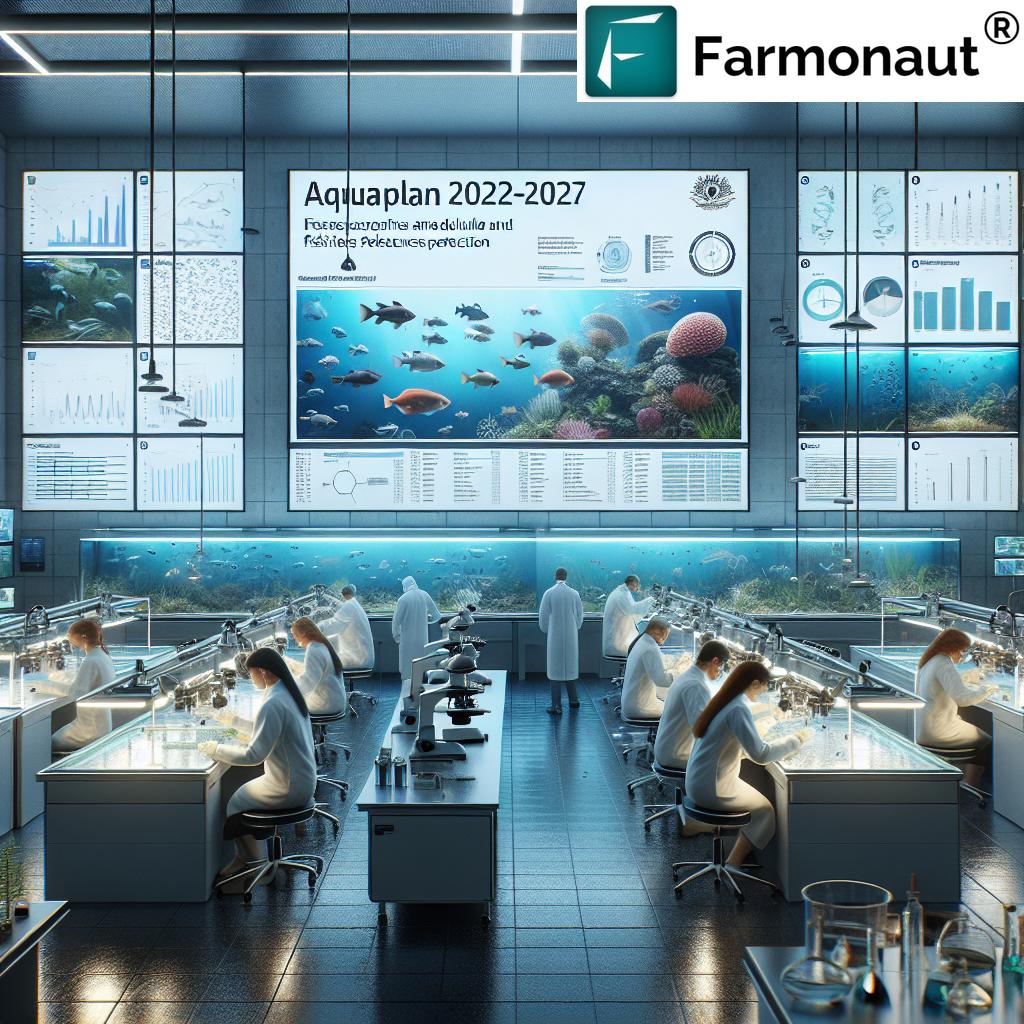Australia’s Biosecurity Strategy: Safeguarding Aquatic Health and Sustainable Agriculture
“Australia’s biosecurity strategy identifies 12 exotic aquatic animal diseases as significant risks to fisheries and aquaculture.”
In the vast expanse of Australia’s diverse ecosystems, the importance of maintaining a robust biosecurity strategy cannot be overstated. As we delve into the intricacies of Australia’s national approach to safeguarding aquatic health and promoting sustainable agriculture, we uncover a comprehensive plan that addresses the multifaceted challenges facing the country’s fisheries and aquaculture industries. This blog post will explore the pivotal role of aquatic animal disease prevention, the implementation of sustainable aquaculture practices, and the collaborative efforts between government and industry stakeholders in managing biosecurity risks effectively.
Understanding Australia’s Biosecurity Landscape
Australia’s unique geographical isolation has historically provided a natural barrier against many pests and diseases. However, in our increasingly interconnected world, the risks of introducing exotic diseases have grown exponentially. The Department of Agriculture, Fisheries and Forestry has taken a proactive stance by establishing a priority aquatic animal disease list, identifying 12 exotic diseases that pose significant threats to the nation’s aquatic ecosystems and agricultural sector.
This initiative forms a crucial part of AQUAPLAN 2022–2027, a strategic framework designed to enhance Australia’s preparedness and response capabilities in the face of aquatic animal health challenges. By focusing on collaboration between government bodies and industry players, this plan aims to create a robust defense against potential biosecurity threats.

Priority Aquatic Diseases: A Closer Look
The identification of 12 priority exotic diseases represents a significant step in Australia’s biosecurity strategy. These diseases have been selected based on their potential to cause severe economic and environmental impacts if introduced into Australian waters. Let’s examine the key aspects of this list and its implications for the aquaculture industry.
| Disease Name | Affected Species | Potential Economic Impact (AUD) | Prevention Measures |
|---|---|---|---|
| Viral Haemorrhagic Septicaemia | Various fish species | $50-100 million annually | Strict import controls, surveillance |
| Abalone Viral Ganglioneuritis | Abalone | $30-50 million annually | Quarantine, biosecurity protocols |
| Infectious Salmon Anaemia | Atlantic salmon | $100-200 million annually | Health certification, monitoring |
| Bonamia ostreae | Oysters | $20-40 million annually | Movement restrictions, testing |
| White Spot Disease | Crustaceans | $50-80 million annually | Biosecurity measures, surveillance |
This table provides a snapshot of some of the priority diseases, highlighting the diverse range of aquatic species at risk and the potential economic ramifications of an outbreak. By understanding these threats, we can better appreciate the importance of implementing robust biosecurity measures across the aquaculture sector.
Aquatic Animal Health Surveillance: A Cornerstone of Biosecurity
One of the key components of Australia’s biosecurity strategy is the enhancement of aquatic animal health surveillance. This proactive approach allows for early detection of potential threats, enabling swift and effective responses to emerging diseases. The implementation of advanced monitoring techniques and diagnostic capabilities plays a crucial role in this effort.
- Satellite-based monitoring: Utilizing cutting-edge technology for large-scale surveillance of aquatic environments
- Regular health checks: Implementing routine inspections and testing protocols in aquaculture facilities
- Data collection and analysis: Gathering and interpreting data to identify trends and potential risks
These surveillance methods form the backbone of Australia’s defense against aquatic animal diseases, ensuring that any potential threats are identified and addressed promptly.
Sustainable Aquaculture Practices: Balancing Production and Protection
In our pursuit of a robust and resilient aquaculture industry, the adoption of sustainable practices is paramount. These practices not only contribute to the long-term viability of the sector but also play a crucial role in minimizing biosecurity risks.
“Australia aims to grow its agricultural sector to a $100 billion industry by 2030 through proactive biosecurity measures.”
Key sustainable aquaculture practices include:
- Integrated pest management: Reducing reliance on chemicals through biological control methods
- Water quality management: Implementing systems to maintain optimal water conditions and reduce stress on aquatic animals
- Responsible feed management: Utilizing sustainable feed sources and optimizing feeding practices
- Genetic diversity preservation: Maintaining genetic variability in farmed populations to enhance disease resistance
By integrating these practices into aquaculture operations, we can create a more resilient industry that is better equipped to withstand potential disease outbreaks while minimizing environmental impacts.
Collaborative Approach: Government and Industry Partnership
The success of Australia’s biosecurity strategy hinges on the effective collaboration between government agencies and industry stakeholders. This partnership approach ensures that biosecurity measures are practical, effective, and aligned with the needs of the aquaculture sector.
Key aspects of this collaboration include:
- Joint research initiatives: Government-funded research programs in partnership with industry to address pressing biosecurity challenges
- Policy development: Industry consultation in the formulation of biosecurity policies and regulations
- Training and capacity building: Government-led programs to enhance industry knowledge and skills in biosecurity management
- Information sharing: Establishing platforms for rapid dissemination of biosecurity alerts and best practices
This collaborative approach ensures that Australia’s biosecurity measures are comprehensive, practical, and responsive to the evolving needs of the aquaculture industry.

Technological Innovations in Aquatic Biosecurity
As we strive to enhance our biosecurity measures, the role of technological innovations cannot be overstated. Advanced technologies are revolutionizing the way we monitor, detect, and respond to aquatic animal health threats. At the forefront of this technological revolution are companies like Farmonaut, which offer cutting-edge solutions for agricultural and aquacultural management.
Farmonaut’s satellite-based monitoring systems provide valuable insights for aquaculture management, offering real-time data on environmental conditions that can impact aquatic animal health. While not specifically designed for aquatic disease detection, these tools can be invaluable in monitoring factors that influence disease susceptibility and spread.
Key technological advancements in aquatic biosecurity include:
- Remote sensing technology: Satellite imagery for large-scale monitoring of aquatic environments
- AI-driven predictive models: Advanced algorithms for early disease outbreak prediction
- Blockchain for traceability: Enhancing supply chain transparency and product origin verification
- IoT sensors: Real-time monitoring of water quality parameters in aquaculture facilities
These technologies complement traditional biosecurity measures, providing a more comprehensive and proactive approach to aquatic animal health management.
Explore Farmonaut’s innovative solutions:
Climate Change and Biosecurity: Adapting to New Challenges
The impact of climate change on aquatic ecosystems presents new challenges for biosecurity management. Shifting water temperatures, altered ocean currents, and changes in salinity can create favorable conditions for the spread of exotic diseases and the emergence of new pathogens. Australia’s biosecurity strategy must therefore be adaptable and responsive to these evolving threats.
Key considerations in addressing climate-related biosecurity risks include:
- Scenario planning: Developing response strategies for various climate change scenarios
- Research into climate-resilient species: Investigating aquaculture species that can thrive in changing environmental conditions
- Enhanced monitoring systems: Implementing advanced surveillance techniques to detect climate-induced changes in disease patterns
- International collaboration: Sharing knowledge and resources with global partners to address transboundary disease risks
By incorporating climate change considerations into our biosecurity planning, we can build a more resilient and sustainable aquaculture industry for the future.
Economic Implications of Effective Biosecurity Measures
The implementation of robust biosecurity measures is not just a matter of environmental protection; it also has significant economic implications for Australia’s aquaculture and fisheries industries. By preventing the introduction and spread of exotic diseases, we can safeguard the livelihoods of thousands of Australians employed in these sectors and protect the substantial economic value they generate.
Economic benefits of effective biosecurity include:
- Sustained industry growth: Protecting the potential for continued expansion of the aquaculture sector
- Market access preservation: Maintaining Australia’s reputation for high-quality, disease-free aquatic products in international markets
- Reduced outbreak costs: Minimizing the financial impact of disease outbreaks through prevention and early intervention
- Investment attraction: Creating a stable and secure environment for domestic and foreign investment in aquaculture
By viewing biosecurity as an investment rather than a cost, we can appreciate its crucial role in supporting the long-term economic viability of Australia’s aquatic industries.
The Role of Research and Innovation in Biosecurity
Continuous research and innovation are essential for staying ahead of emerging biosecurity threats. Australia’s commitment to scientific excellence in this field is evident through its support for various research initiatives and collaborations.
Key areas of biosecurity research include:
- Pathogen genomics: Understanding the genetic makeup of priority diseases to develop targeted control strategies
- Diagnostic tool development: Creating rapid and accurate testing methods for early disease detection
- Vaccine research: Developing preventive measures against priority aquatic animal diseases
- Ecosystem modeling: Predicting disease spread patterns in complex aquatic environments
These research efforts contribute to the development of more effective biosecurity strategies and support the ongoing adaptation of our approach to emerging threats.
International Cooperation in Aquatic Biosecurity
Aquatic animal diseases do not respect national boundaries, making international cooperation a crucial aspect of effective biosecurity management. Australia actively participates in global initiatives and partnerships to enhance its biosecurity capabilities and contribute to worldwide efforts in disease prevention and control.
Key aspects of international cooperation include:
- Information sharing: Participating in global disease reporting systems and early warning networks
- Capacity building: Providing training and support to neighboring countries to enhance regional biosecurity
- Research collaborations: Engaging in international research projects to address common biosecurity challenges
- Policy harmonization: Working towards aligned biosecurity standards and protocols across trading partners
Through these collaborative efforts, Australia not only strengthens its own biosecurity measures but also contributes to global aquatic health and food security.
The Future of Aquatic Biosecurity in Australia
As we look to the future, the landscape of aquatic biosecurity in Australia continues to evolve. The integration of advanced technologies, the adaptation to climate change impacts, and the ongoing commitment to research and innovation will shape the next generation of biosecurity strategies.
Key trends and future directions include:
- Precision aquaculture: Utilizing data-driven approaches for more targeted and efficient biosecurity measures
- One Health approach: Recognizing the interconnectedness of human, animal, and environmental health in biosecurity planning
- Citizen science initiatives: Engaging the public in biosecurity efforts through awareness campaigns and reporting programs
- Regulatory innovations: Developing flexible and responsive regulatory frameworks to address emerging biosecurity challenges
By staying at the forefront of these developments, Australia can continue to lead in aquatic biosecurity and sustainable aquaculture practices.
Conclusion: A Collective Responsibility
Australia’s biosecurity strategy for safeguarding aquatic health and promoting sustainable agriculture is a comprehensive and forward-thinking approach to protecting one of the nation’s most valuable resources. The success of this strategy relies on the collective efforts of government agencies, industry stakeholders, researchers, and the broader community.
By prioritizing aquatic animal disease prevention, implementing sustainable aquaculture practices, and fostering collaboration across sectors, Australia is well-positioned to meet the challenges of the future. As we work towards the goal of a $100 billion agricultural industry by 2030, the importance of robust biosecurity measures cannot be overstated.
In this endeavor, the role of innovative technologies and data-driven solutions, such as those offered by companies like Farmonaut, will be increasingly crucial. While not directly involved in aquatic biosecurity, Farmonaut’s agricultural technology solutions demonstrate the potential for advanced monitoring and management systems in related fields.
As we move forward, let us remember that biosecurity is not just a government responsibility but a shared commitment to protecting our aquatic ecosystems, supporting sustainable agriculture, and ensuring food security for generations to come.
FAQ Section
Q: What is Australia’s priority aquatic animal disease list?
A: It’s a list of 12 exotic diseases identified by the Department of Agriculture, Fisheries and Forestry as significant risks to Australia’s fisheries and aquaculture industries.
Q: How does climate change impact aquatic biosecurity?
A: Climate change can alter water temperatures and ocean currents, potentially creating favorable conditions for the spread of exotic diseases and the emergence of new pathogens.
Q: What role does technology play in aquatic biosecurity?
A: Advanced technologies like satellite monitoring, AI-driven predictive models, and IoT sensors enhance surveillance, early detection, and response to aquatic animal health threats.
Q: How does Australia collaborate internationally on biosecurity?
A: Australia participates in global disease reporting systems, engages in international research collaborations, and works towards harmonizing biosecurity standards with trading partners.
Q: What are sustainable aquaculture practices?
A: They include integrated pest management, responsible feed management, water quality management, and preserving genetic diversity to minimize environmental impacts and reduce biosecurity risks.
For more information on agricultural technology solutions, visit Farmonaut’s API and explore their API Developer Docs.
















